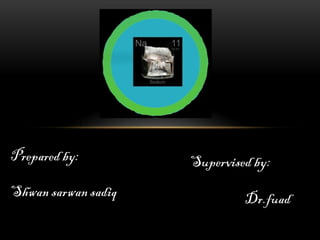sodium Na (natrium)
•Download as PPSX, PDF•
1 like•1,790 views
this presentation made by koya university student of chemical engineering department shwan sarwan
Report
Share
Report
Share

More Related Content
What's hot (20)
More from sarkawtn
More from sarkawtn (15)
Conductivity measurement water-base(temperature is not included)

Conductivity measurement water-base(temperature is not included)
Conductivity measurement in CSTR water-base(according to temperature)

Conductivity measurement in CSTR water-base(according to temperature)
Nano-materials using in chemical engineering (Nano Catalyst)

Nano-materials using in chemical engineering (Nano Catalyst)
Boyles law (compresion) (relation between pressure & volume)

Boyles law (compresion) (relation between pressure & volume)
sodium Na (natrium)
- 1. Prepared by: Shwan sarwan sadiq Supervised by: Dr.fuad
- 2. List of content : • • • • • • • • Essential information of sodium Where does the name came from? Where & how ? Characteristic properties History of sodium What is it used for? Current event article and fun facts? Bibliography
- 3. Essential information of sodium
- 4. Where does the name came from? • The word sodium comes from the Latin word sodanum and the English word soda which both mean “” head ache remedy”” • Na comes from the Latin word natrium which means sodium carbonate.
- 5. Where & how ? • 2.6% of earth’s surface is made up with with sodium but since it is so reactive it is never found free in nature. • To store pure sodium it has to be contained in a moisture free environment.
- 8. What is it used for? • • • • • • Table salt (NaCl) Soda ash(Na2Co3) Baking soda (NaHCo3) Caustic soda (NaOH) Chile saltpeter (NaNO3) Borax (Na2B4O7.10H2O)
- 9. Current event article and fun facts?
- 11. Thank you
